Solar Strike – Product Reviews Warm WOM, Heat Sales, Burn You

Solar flares are awesome in their beauty, power and effect on us here on Earth.
In a weird sorta’ way, they are similar to firms’ product review efforts. Nothing warms the boss’ heart, makes sales grow more than great reviews and word-of-mouth (WOM).
Less than perfect reviews cause electric storms and wreak havoc throughout the organization…especially for the communications team.
There are two reasons product reviews are important and the efforts shouldn’t be taken lightly:
- In today’s rapidly changing business and entertainment environment, firms have to make a fast, hard-hitting impact with new products to be heard above the online noise. Speed and positive impact isn’t just important … it’s vital.
- Before making a purchase, 70 percent of consumers (B2B, B2C) look at product reviews first, according to a report by ChannelAdvisor. They trust those reviews (publication and customer written) 12x more than company written product descriptions.
Eighty-eight percent of the respondents trust online reviews as much as personal recommendations.
Getting those reviews isn’t easy and the results aren’t always (heck, make that seldom) as good as the boss would like.
Part of the problem is that even in today’s open communications environment, too many people still think of reviews as “free advertising.”
Reviews aren’t free.
Reviews aren’t advertising.

Today, nearly every person with internet access is influenced by media and consumer reviews. According to ChannelAdviser:
- 64 percent of shoppers took 10 minutes or more to read reviews
- 33 percent took a half hour or more to read reviews
- 39 percent read eight or more reviews before buying
The volume of information available online has shifted the balance of power from the company to the consumer. These people want to make their buying decisions independent of what companies say about their products and they want to know more than just specs and price.
As with traditional word-of-mouth research, internet users seek out information and insights to compare products, services and even brands.

Even with teens who have grown up online, friends are still their top source of information; but the importance and trustworthiness of publication and customer reviews has grown rapidly.
There are, however, some important dos and don’ts for the activity to keep in mind and make them an integral part of your corporate, marketing efforts.
Dos
There are two flavors of reviews – technically/journalistically experienced publication reviews and customer reviews.
- With minor variations, your review activities are basically the same.With a publication/site reviewers, get to know their wants and needs. Gain their trust and respect – handing everything in a prompt/professional manner. Know the medium they write for, understand their specific areas of interest/focus.
In addition to the product/service make certain they have all of the technical, application information/video content required to deliver a true, accurate, unbiased report to their readers. Respect their findings/interpretations even when they hurt … a little.
No reviewer will follow your product script. If the product or service falls short of their expectations, 90+ percent of the time they won’t give it a minus five stars. Instead, they will simply not publish the review, ship the whatever back or give it to Goodwill and suggest you go back to the drawing board on that one!
2. Request that people identify their review, either with their real name or cool online name. Few people trust anonymous reviews because they feel they were paid reviews, employee-generated (yep, it’s done) or from competitors (especially negative reviews). Readers/viewers aren’t stupid and if this is one of your favorite guerilla efforts … knock it off!
3. For consumer reviews, verify as much as possible that the individual actually purchased the product so that it is credible to others. Amazon, Yelp and other site reviews often suffer because the reviews are either so good or so bad they stretch credibility.
4. If the review is negative or the reviewer takes issue with aspects of the product/service, respond in a positive, constructive manner. Explain the company’s view, cover design/usage points from the company’s perspective and if there were legitimate questions/issues, address them in a pro-active manner.
5. Monitor and moderate the reviews. Don’t expect every review to be a 5-star review. Moderate reviews to make sure you don’t display anything inappropriate or overly negative, but you shouldn’t be greedy about 5-star reviews. If every product on your site is excellent, you’ll perhaps lose credibility. Be okay with 3- and 4-star ratings.
6. Be available. Reviewers (media or individual) go through the installation, operation and testing at all hours. When they’re in the middle of the project and encounter an issue or have a question, they can’t wait until you get around to responding when it’s convenient. Monitor your email/smartphone and be available. If the questions are “above your paygrade,” have immediate access to a couple of technical specialists to assist your reviewer. If the reviewer doesn’t get a timely response/assistance, he or she will fill in the blanks on their own. That’s your fault, not theirs.
7. Don’t expect the review to follow your product description script. That copy was prepared by marketing or engineering and is often very different from real people who focus on actual experience, use and as they say, “your mileage may vary.”
8. Don’t ignore a bad review because with the right, positive response you may be able to turn a negative into a positive. At the same time, bad reviews aren’t necessarily bad. They may point out installation/operation documentation problems that need to be corrected. They may point out that your vision of how the product/service would be used is totally different from real user experience. They may point you to a product issue that needs to be corrected. Learn from the review, make the corrections/adjustments and let the reviewer know what was done to correct the situation and thank him/her for their assistance. Don’t take a less than five-star review personal; be professional and you could end up with a very enthusiastic advocate.
9. A review isn’t a testimonial, so don’t squeeze out all of the best comments and use them as such. If you want to use the review on your website, make certain you check with the reviewer first and get approval. If it’s in a publication/site, they usually have rules as to how their name/logo is used, so abide by them.
Don’t
- Don’t ask for a positive review at the beginning of the process; ask for an honest, credible review.
- Don’t ask the reviewer to change the copy so it agrees with your product documentation. You – and more importantly, consumers – want actual experiences and credible information.
- Don’t offer anything for a good review at the beginning of the process whether it’s keeping the product/service or offering a significant discount. Often companies don’t expect the product to be returned –the cost of putting the product back in the inventory is often more than your real costs – but that offer should be made after the review is done, not at the beginning. Respect the reviewer’s professionalism.
- If it’s a negative review, don’t automatically lash out. Study the review carefully and determine if there are factual errors, differences of opinion or one of those people who can’t be satisfied. If at all possible, take the discussion offline and try to resolve the issue(s) in a professional, constructive manner.
Getting good reviews in the media and online isn’t easy, and most of them won’t be five-star ratings and outstanding accolades.
But the difference between a good and great company is how it earns and handles its reviews … especially mediocre or negative reviews.
There are no shortcuts to getting good media/online reviews but they are very important in creating strong, positive, action-oriented word of mouth (WOM) and sales.
It’s worth the effort.

# # #